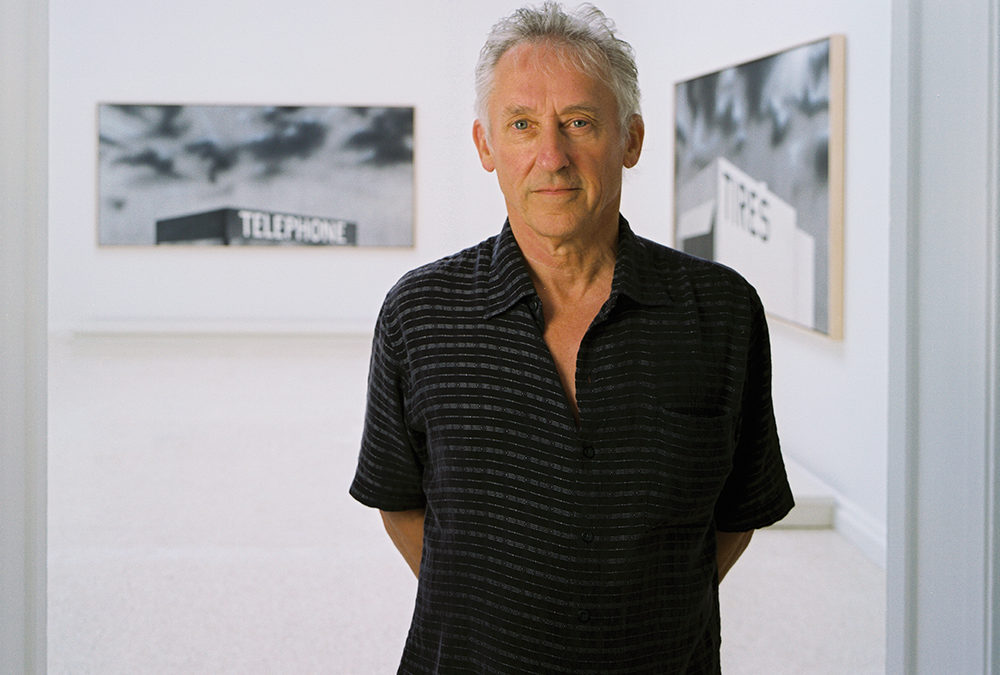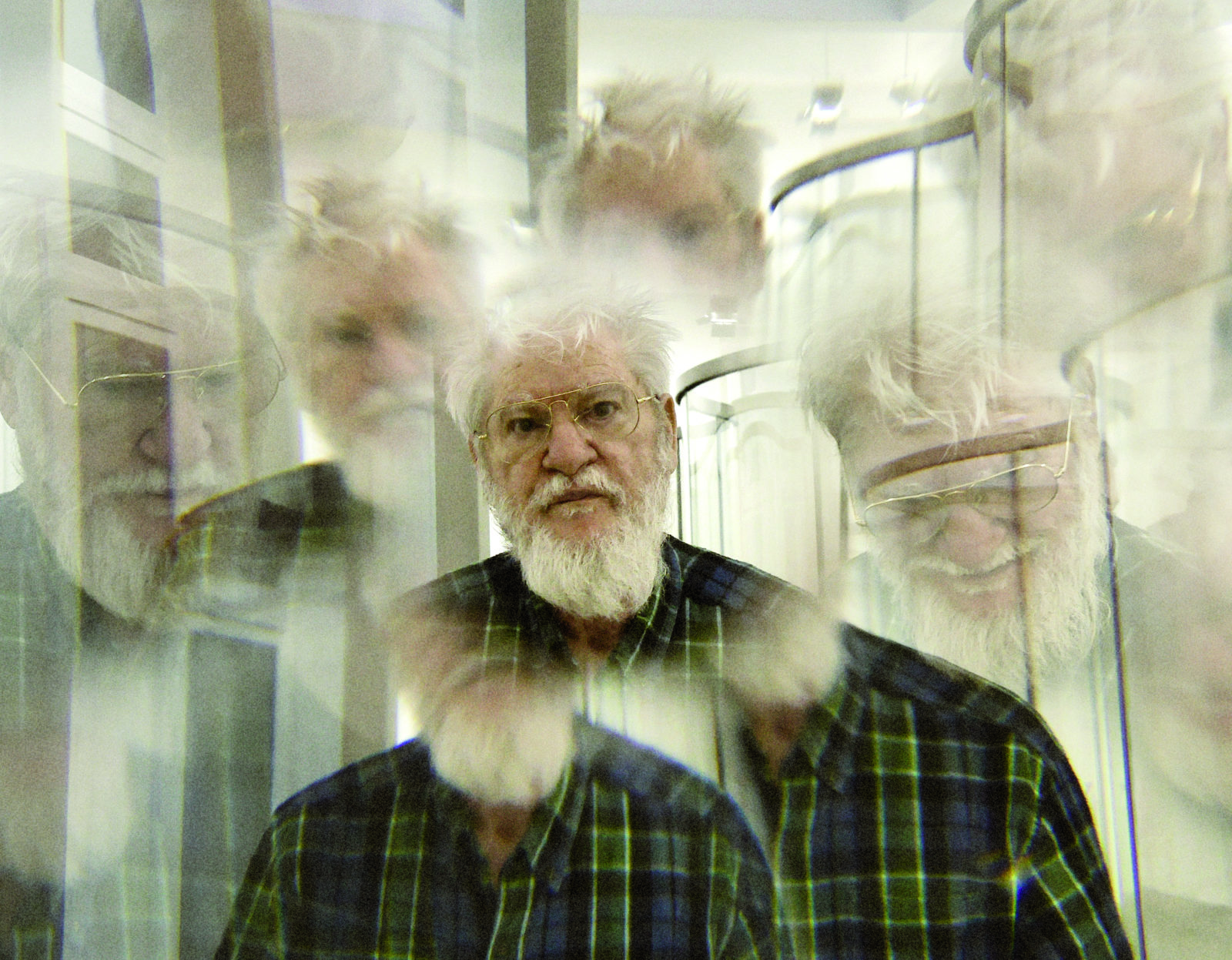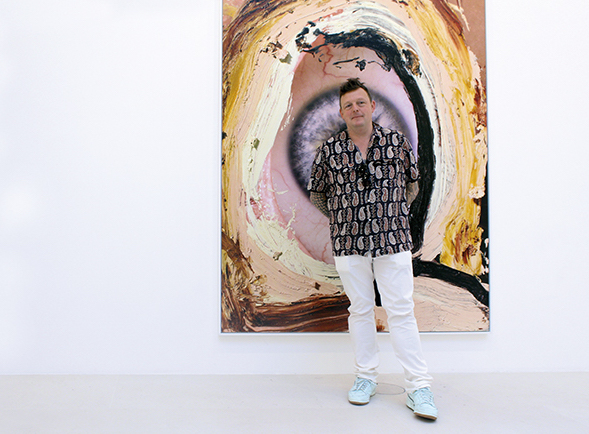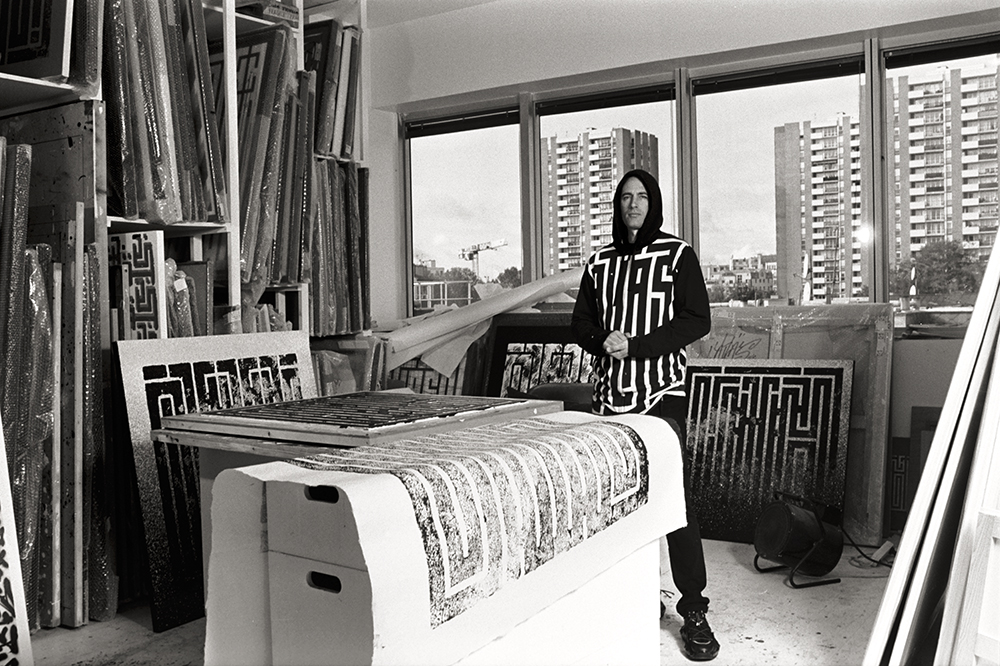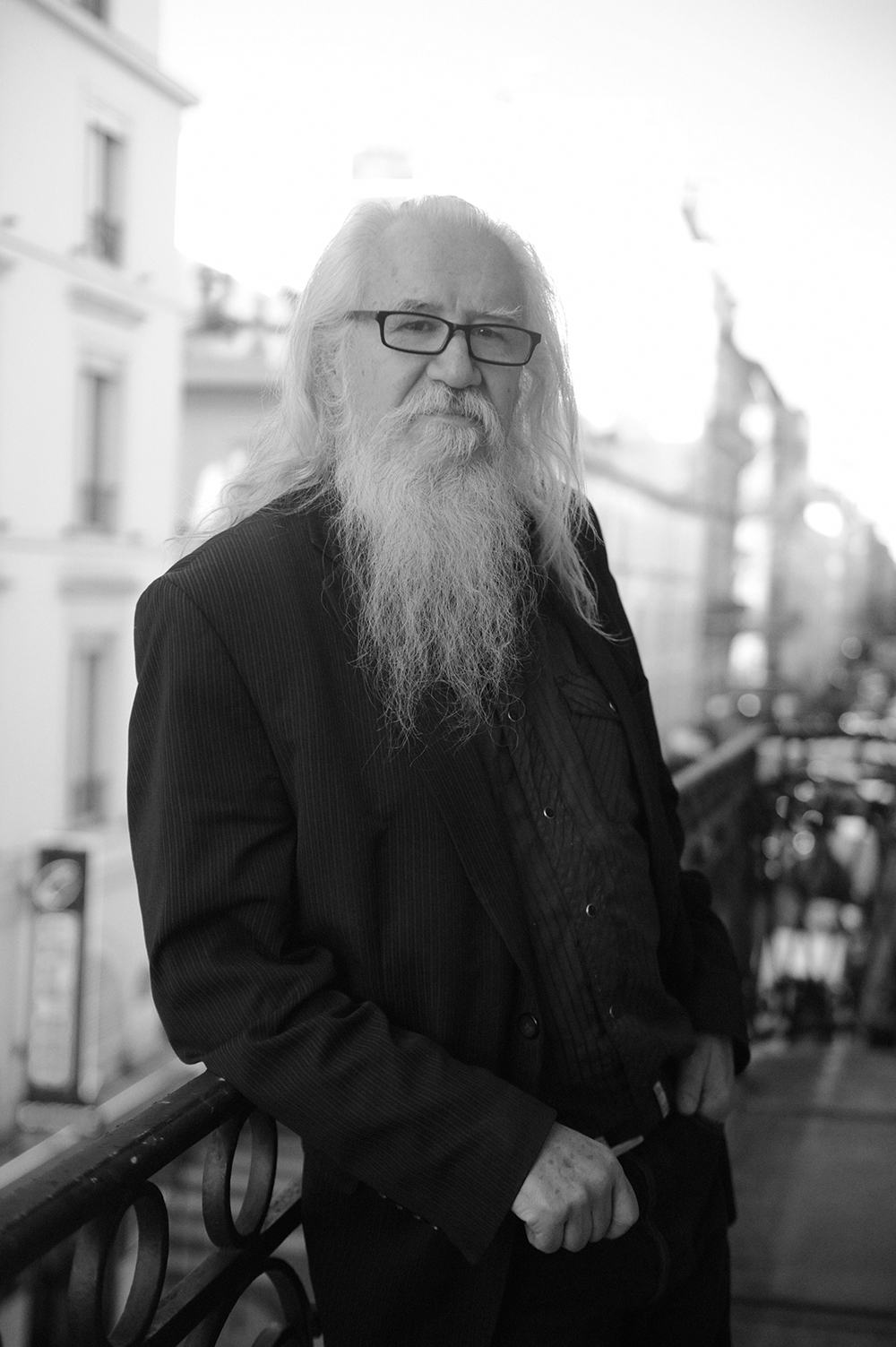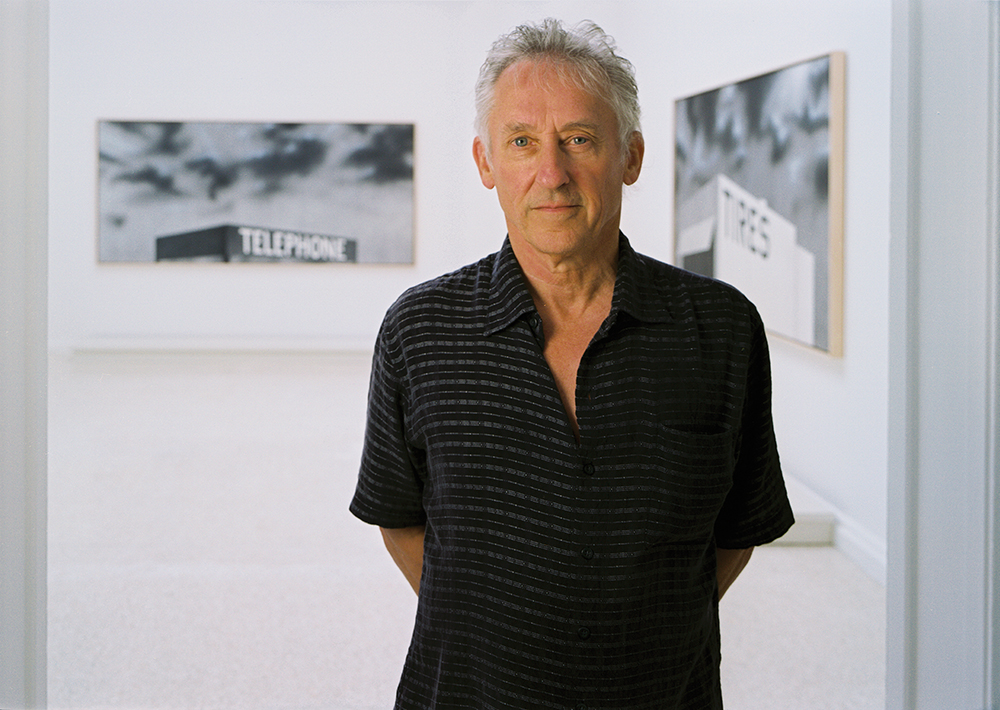
A MEETING WITH ED RUSCHA
By Yan Céh
One of the most iconic West Coast artists, Ed Ruscha has become a living legend of art history. Combining pop and conceptual art, his word and phrase paintings have influenced many. Ruscha has always loved to experiment with new forms: he is also known for his photography, drawing, and above all his books, which he began creating in the 1960s as complete works of art in their own right. Beginning with “Twentysix Gasoline Stations” in 1962, the publications garnered little interest at first, but have since grown into rare cult items. Today, it is precisely these books, photographs, and prints that Gagosian Gallery has chosen to exhibit at its Paris location. Revisiting over 40 years of the artist’s work, the show is a unique opportunity to discover the Ed Ruscha’s creative universe.
Are you still making pictures when you’re traveling? Do you have a digital camera or an old one?
I have a digital camera, but I barely know how to use it. I take pictures but I don’t do much with them… You know, I don’t use pictures so much in the rest of my art, like I did in the past. Before, I would use photographs of gasoline stations to help me complete a painting. Today I don’t operate like that so much.
What about the mountains in your paintings?
Sometimes they’re from existing photographs.
Like pictures out of The National Geographic magazine?
Any kind of things. It’s about the mountains or some kind of ideas of mountains, rather than specific mountains… You know.
But they do look like photographs, they’re very realistic…
Yeah. But I don’t use a camera to help me with that…
It doesn’t interest you anymore?
Not so much. You know, there’s so much material, imagery, photographic images in the world today… You can find everything!
We’re surrounded…
Exactly. You are surrounded by that, so you can’t help it but to have some idea of anything. Even if it’s to confuse you, you know. You get confused by looking at all these pictures. There is too much information in the world. Photographic, everything, even art! When looking at an art magazine you would say: “Wow, I did not know there were so many artists out there.” I mean so many people are making so many things, that it’s almost too much to swallow. It makes you dizzy.
When you began doing art, the context was different. Art was not so fashionable. Today, art and fashion are often put together. What do you think of that?
I think the information is so abundant today, there’s so much of it, and it’s very confusing. We have to remember how small the world used to be in 1960. Not that much was going on. There was New York, and that was it. Over there, they were making beautiful abstract paintings. But it was such a small world…
And there were many things to do at that time…
Indeed. The art world used to organize itself at one place, New York, and maybe Chicago or some big cities. Now it’s everywhere. Everybody knows everything from the information highway.
In that new world, you’ve become huge. In every art school around the globe, you’re such a big influence on younger generations… Even on contemporary artists. Think about Richard Prince for example.
Oh, boy… Well. The hard part about it is that the people that I knew, probably Richard Prince too, never had the notion that they could make a living out of this. You couldn’t have some master plan at that time. Art schools today know that painters come out and they’re ready to take over the world. It’s just a very different situation compared to what it was like fifty or forty years ago.
But, at that time, when you were doing the paintings or the books, were you thinking that you might have a breakthrough and become what you actually are today?
Everyone wants to do that, to become an artist and live like one. For me, there was nothing else to do, and I knew that I wanted to have my time, take my time, because I was making commercial art and I didn’t like it. So I knew that I had to leave that behind…
In the first volume of your catalogue, I discovered some of your paintings with birds, which are pretty rare.
Oh yeah. That’s one of the contradictions in my work. I painted oversized objects like birds, and the birds were much bigger than in real life. Up to then, I had only painted pictures of realistic things that were their exact size, like this piece of paper, or that pencil (showing them on the table), or a can of meat… So, painting things natural size was an important step for me.
So those birds…
Birds went out somewhere else, I went haywire… Haywire. Like you take this wire, and this wire and you go crrrrrrricccccrcccciiccccc (making electrical noises). That’s what it’s like! (laughs)
And do you still like living in Los Angeles?
It has changed a lot of course, but I still do like it. And also, I have this love/hate relationship with the city. Now I tolerate the city and I just live there because that’s where I live. (laughs) That’s very Gertrude Stein to say that. That’s something she might say: I live there because that’s where I live.
Do you think painting is still an interesting medium?
I do. Nowadays, a lot of people say that everything has been done. I don’t think it’s true at all. All you have to do is look at what the artists are doing today. They’re making paintings on rigid formats, rectangles, flat panels – like they always have. Like they did in the Renaissance. But they’re still managing to make new imagery…
What’s your process when making a new painting today?
I go to my studio every day. Sometimes I make no art. I just go to my studio, and I walk, from here to there, and to there, and to there… And I’m thinking… Then I go into an idea, and from that idea, to a drawing, a painting, something… The unknown is one facet of being an artist that has the most to offer to me. Not knowing what’s going to happen, what’s in the future. I have always felt that way. I have always wondered what direction I will take at some point in the future, or how will my future unfold. That is one thing I’m baffled by but also committed to. I have no plans. I’m most fascinated by that one idea of the things that are undone now, will be done in five years’ time. Making art is a kind of curious individual enterprise. It all depends on me and not somebody else. I can’t get fired from the job. I’ve felt like firing myself, but I know I am helpless.
Are you listening to music when you’re working?
Sometimes. But I never know how much time it takes me to do things. Sometimes I work on four things at once. I have no strategy. I’ve always felt like the number one rule is that there is no rule.
Can you tell us about the words you’ve been painting for so long now?
Well… Some are found like this, readymade, some are dreams, some come from newspapers. I like to say they are finished by blind faith. My mind seems to wrap itself around that thing until it’s done. It’s strange and I don’t know what motivates me. Each of the works is premeditated. I keep notebooks. The initial ideas are written out. I don’t draw them, I just stage them onto canvas. I never stand in front of a blank canvas waiting for inspiration.
Do you buy art?
Sometimes. I sometimes trade for art, too. Sometimes I buy photographs. A few years ago, I bought some pictures of Hiroshi Sugimoto. I bought some photographs of the series about the movie theatres. I like the concept of what he did with the movie theatres: put a camera in an empty theatre and play the movie all through, the entire movie…
Do you like William Eggleston?
Of course, he’s very good, I like him a lot… And Stephen Shore, also. I really like his work, too. Great pictures.
There’s a connection with your work in the pictures of Shore and Eggleston…
Yes, completely… Talking about collecting, I collect books. I like books a lot. So many books. It’s impossible to keep up with books… Novels, essays, pictures…
There are also a lot of books about your work now. You’re even on TV shows. I remember seeing you in a show on E! Television, talking about Lauren Hutton…
Yes ! (laughs) She’s an old friend. She’s a wonderful person. I’m lucky to know her, and when they asked me, I just accepted to talk about her and the way she’s always doing great things. She’s a great woman.
Are you friends with other actors in Hollywood?
I think just the fact that I’m living in California helps… You would think that the people in the movie business, just because of their interest in storytelling and art, would be buying or collecting art. But they don’t. They don’t really care about us so much. We know more about them than they know about us. We probably appreciate them more than they appreciate us. I think that’s true.
Did you ever meet people like David Lynch, for example?
I met him, I know him. He is a really nice guy. He’s into movies of course, but he’s an artist too. I know some paintings he did, with shadows, obscure things…
Talking about music, what are you listening to?
Well, I listen to rhythm & blues, and music from the Fifties… Doo wop music and also some country western music, and jazz… I like country and western songs mostly. I like music because there are thought patterns that those people put into their music. It is music but it is also words, and I’m involved in words, too. I guess they’re artists on the same plane as I am, but in some funny way they’re very distant from me. But close enough to me that I’m intrigued by it, and I’m also influenced by it. I find that some musicians are making a more cohesive statement to me than many artists, even artists whom I admire. I think that some of the musicians are bridging many gaps that I’d like to see myself bridge. For that reason, music interests me. Frank Zappa will use some Tin Pan Alley music for a few seconds to make a certain statement, whereas I don’t go back and borrow things from the past like that. But musicians go back and use all kinds of things through history to make their statement cohesive…
What about the Talking Heads? Their greatest hits album, “Sand in the Vaseline,” features one of your paintings on the cover.
Right. I knew David Byrne. He takes photographs, I don’t think he paints. He’s doing art. He liked this painting and just asked me if he could use it. In the music business, they’re not usually interested in understanding your art, they just want a picture to put on top of a record… So when Byrne asked me about “Sand In The Vaseline,” I said they just couldn’t write things on top of it, so they put things around it… (laughs)
But they have respected the work.
Yes, they have. Another person who is a movie director and has a very good eye, like Byrne, is Wim Wenders. He’s a pretty good photographer…
He is! Do you have an idea of what you would have done if you were not an artist?
I thought maybe I wanted to be a weatherman. Study the weather…
Present the weather on TV or radio, or just study it?
No, not presenting the weather on TV, but being a meteorologist!
I’m saying that because I saw some pictures of you during your performances, or while making your books, in the Sixties. And you look great, like a Hollywood actor.
Well… (laughs) I did one piece of acting, in a movie. It was called “Choose Me.” It was directed by Alan Rudolph. That was thirty years ago…
You should have done something with Dennis Hopper. He’s so into art also…
Dennis! He used to shoot pictures all the time. He was crazy about photography.
He was crazy about everything.
Yes, he was a wild man for a while!
What are you doing when you’re not working in your studio ?
I go to the desert. I like to hike in the desert. That’s my big exercise. Desert and no people. That’s good. I have a little place in the desert. It’s a way to remove myself from the city. I used to motorcycle in Mexico, on dirt roads, not on the highway. I have not done that so much lately. I had a spinal operation and my balance is a little bit off. When I’m on my motorcycle I don’t want to be a little bit off ! (laughs)
Did you ever go for a motorcycle ride with Keanu Reeves? It’s said that he’s always on his motorcycle…
Yes. That’s right. I know him, I did a painting for him. I talked to him a few times. He’s kind of mysterious anyway. But he’s a cool guy.
Which are your favorite movies?
I think my favorite movie is “Cul-de-sac” by Roman Polanski. It’s a great movie. I also like “Paths of Glory” by Stanley Kubrick. I could also add some really old black-and-white movies like “Nosferatu,” that’s a good one. And “Un Chien Andalou”…
It’s a lot of European movies!
There’s also a B-movie, of 1947, “Try and Get Me”… I remember this peculiar movie. Not to forget “The Man who Fell to Earth” with David Bowie.
What do you think of American culture today?
American what? Torture?
No, culture…
Oh, “culture”! When I think about the United States, I almost get a patriotic heart pounding… I believe there is so much there that is vital, that I think I always wanted to be a part of it.
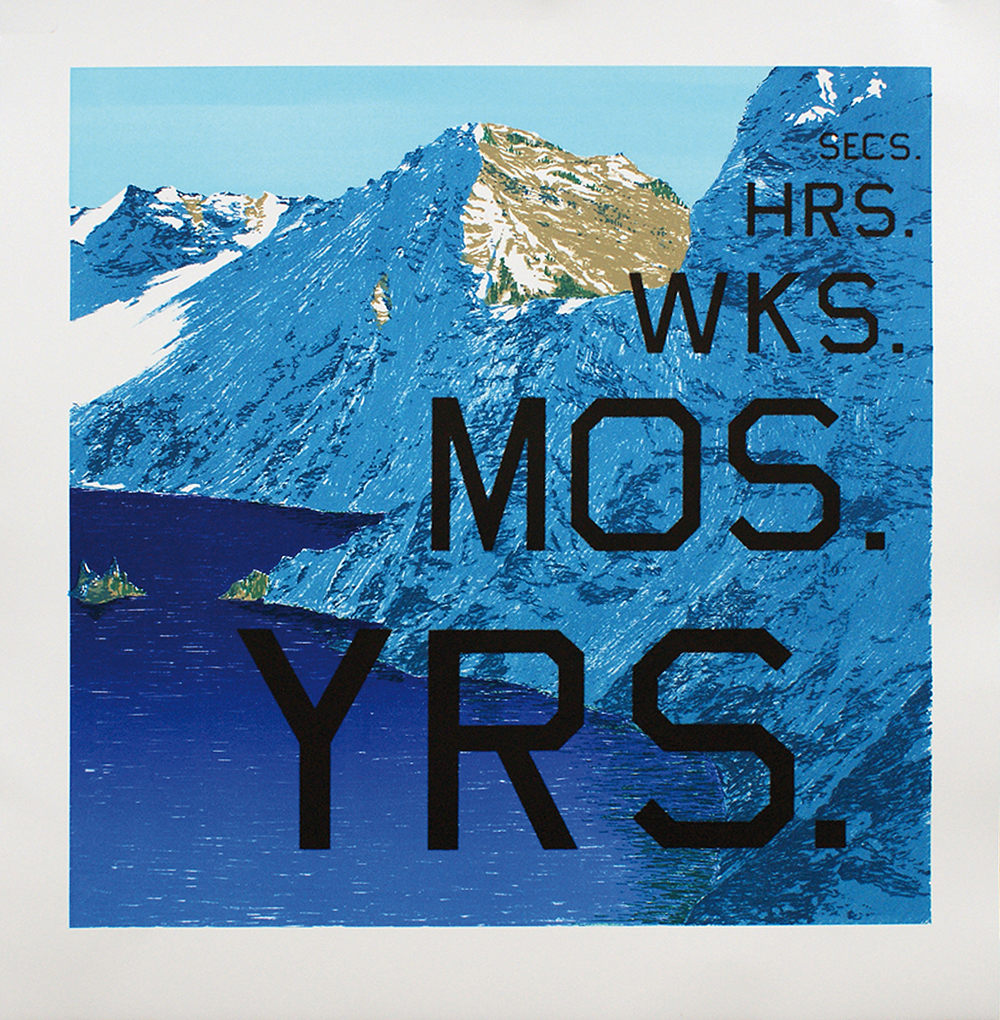
Ed Ruscha, Periods, 2013
Litograph, 28 3/4 x 28 inches
© Ed Ruscha, Courtesy Gagosian Gallery, Photography by Robert McKeever
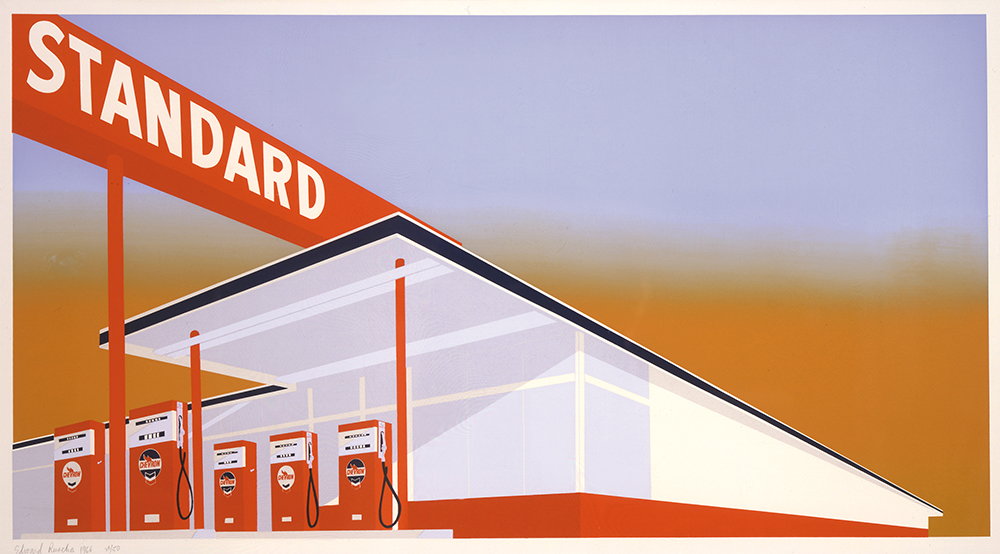
Ed Ruscha, Standard Station, Mocha Standard, Cheese Mold Standard with Olive, and Double Standard, 1969
Four screenprints on wove paper, 25 3/4 x 50 inches
© Ed Ruscha. Courtesy Gagosian Gallery. Photography by Robert McKeever
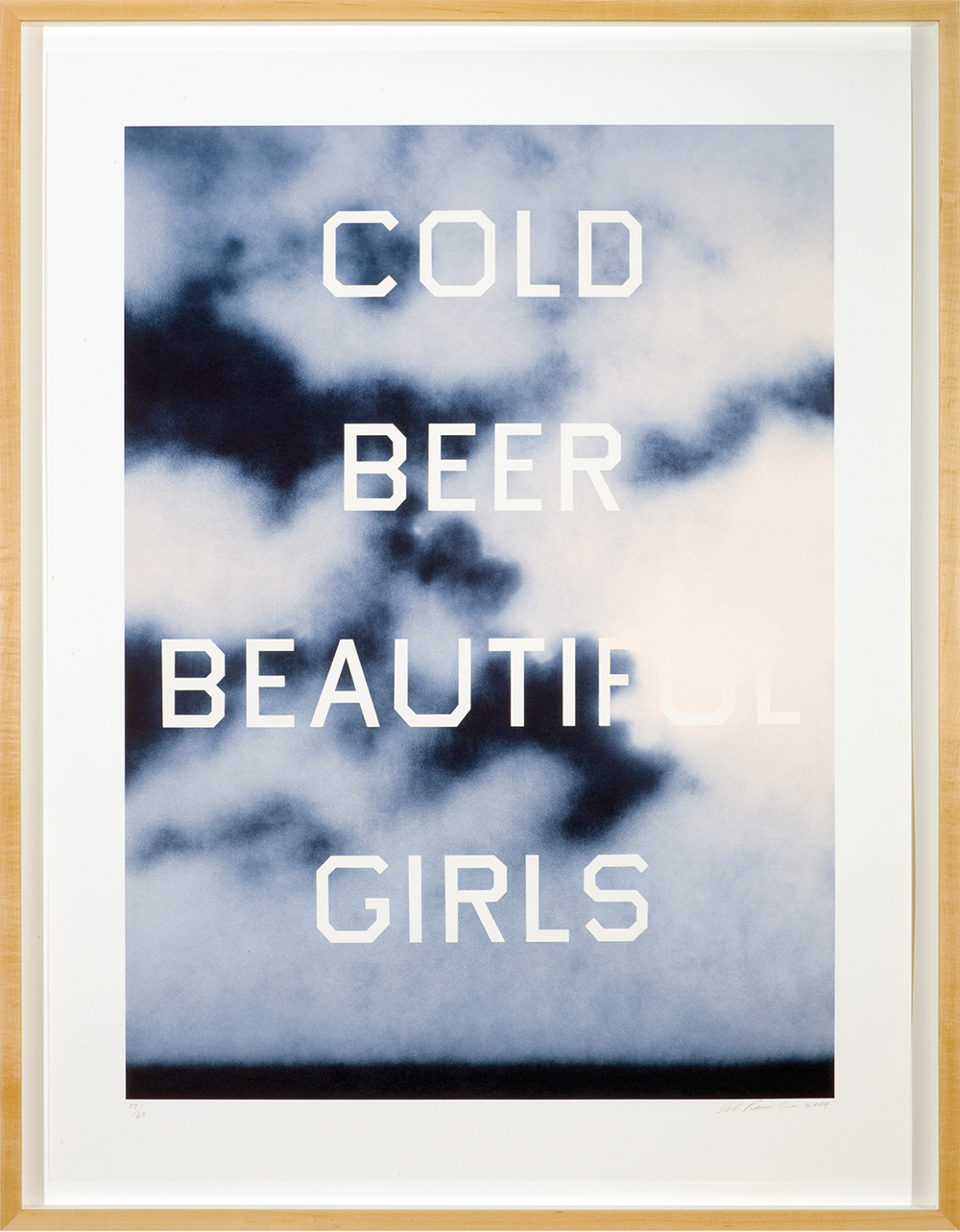
Ed Ruscha, Cold Beer Beautiful Girls, 2009
Digital lithograph 40 3/4 x 30 3/4 inches
©Ed Ruscha. Courtesy Gagosian Gallery. Photography by Robert McKeever.
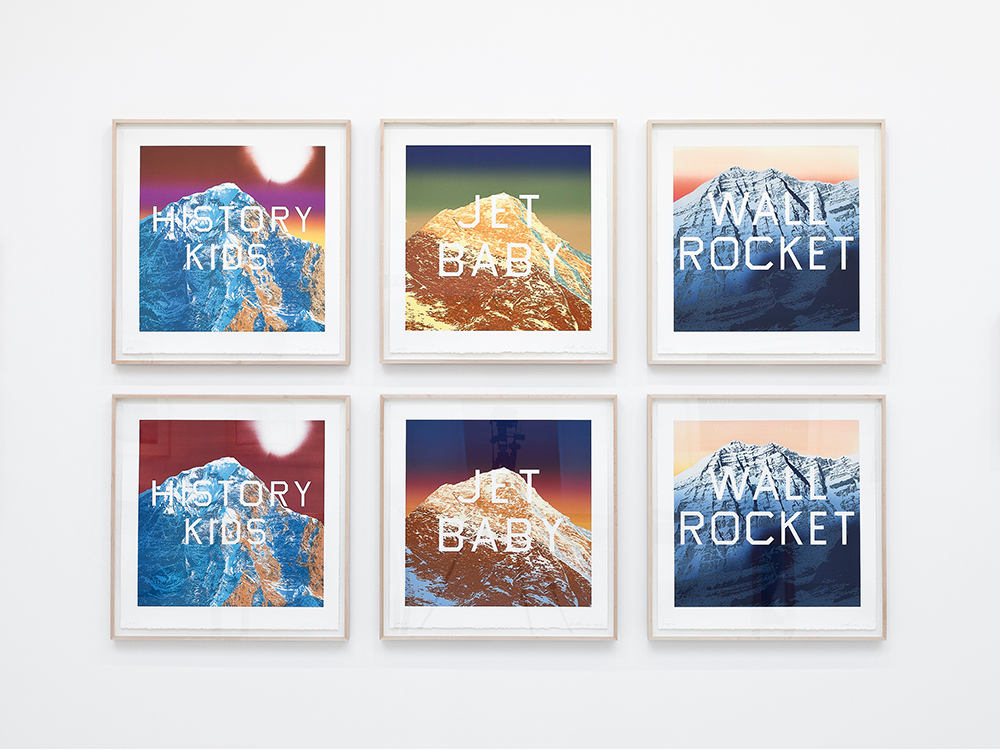
Ed Ruscha: Prints and Photographs
©Ed Ruscha. Courtesy Gagosian Gallery. Photography Zarko Vijatovic.
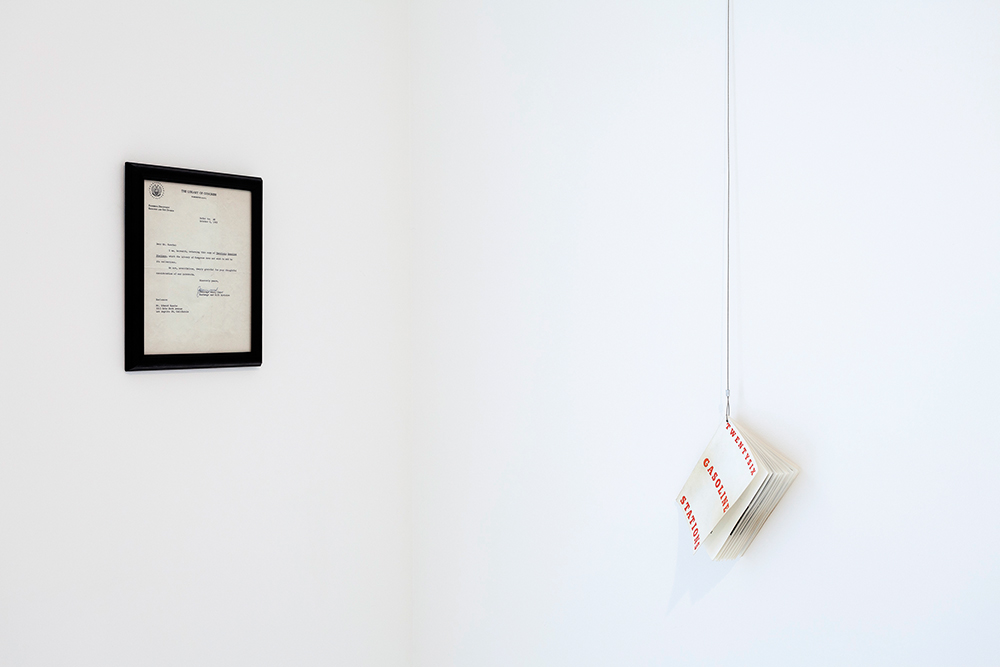
Ed Ruscha: Books & Co
©Ed Ruscha. Courtesy Gagosian Gallery. Photography Zarko Vijatovic.
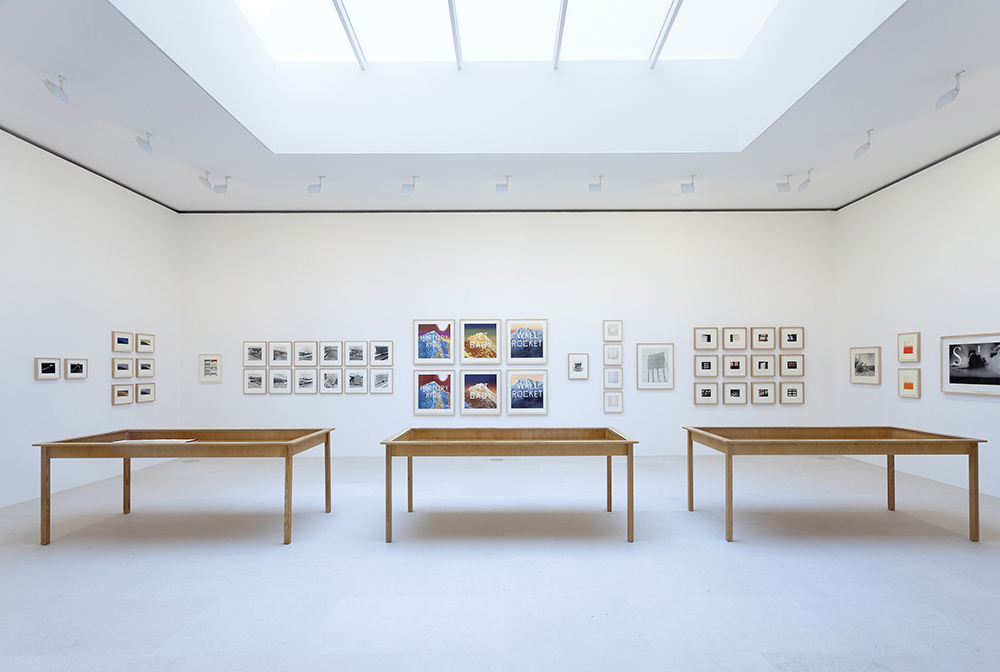
Ed Ruscha: Prints and Photographs
©Ed Ruscha. Courtesy Gagosian Gallery. Photography Zarko Vijatovic.
Interview by Yan Céh.







